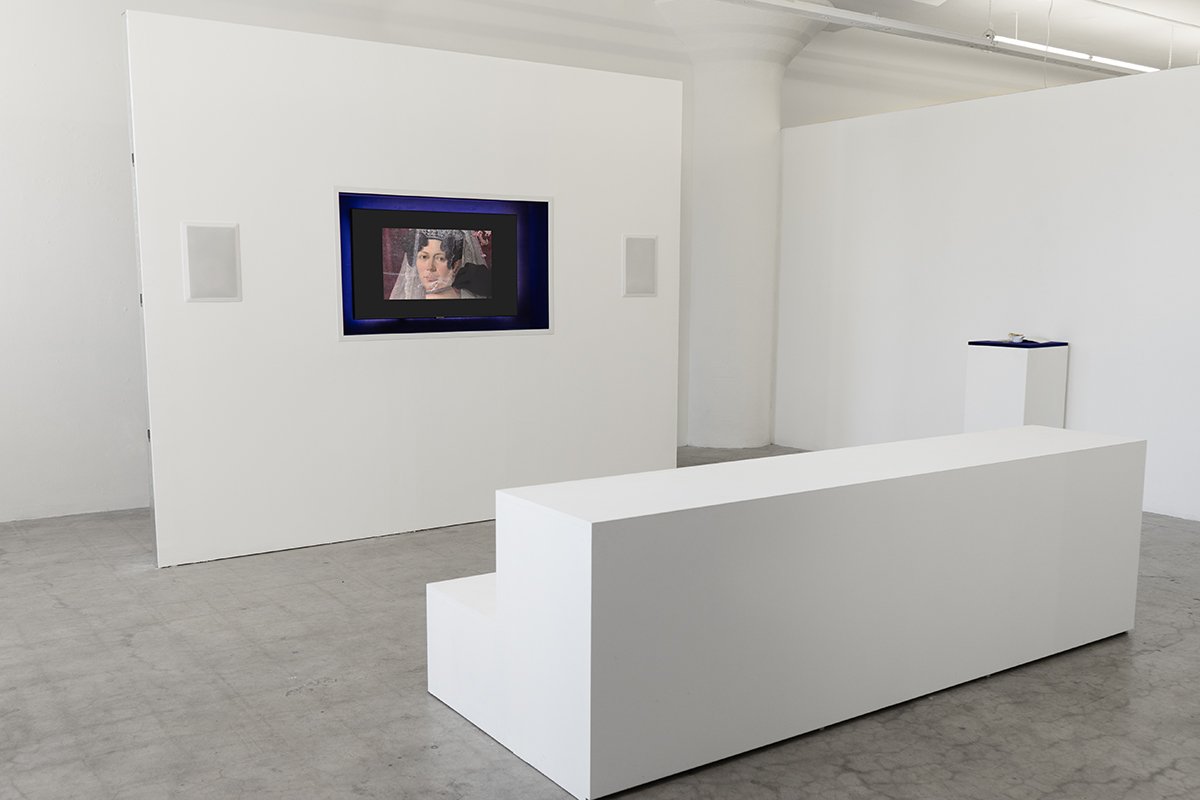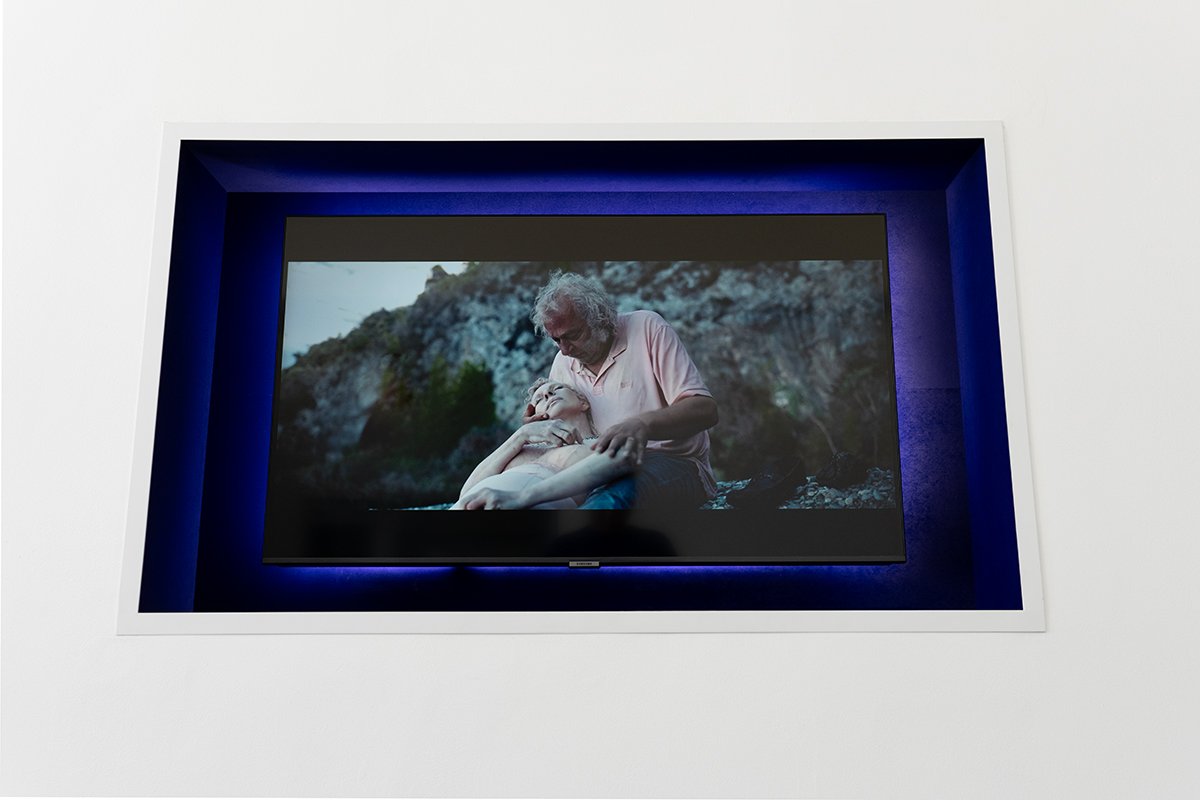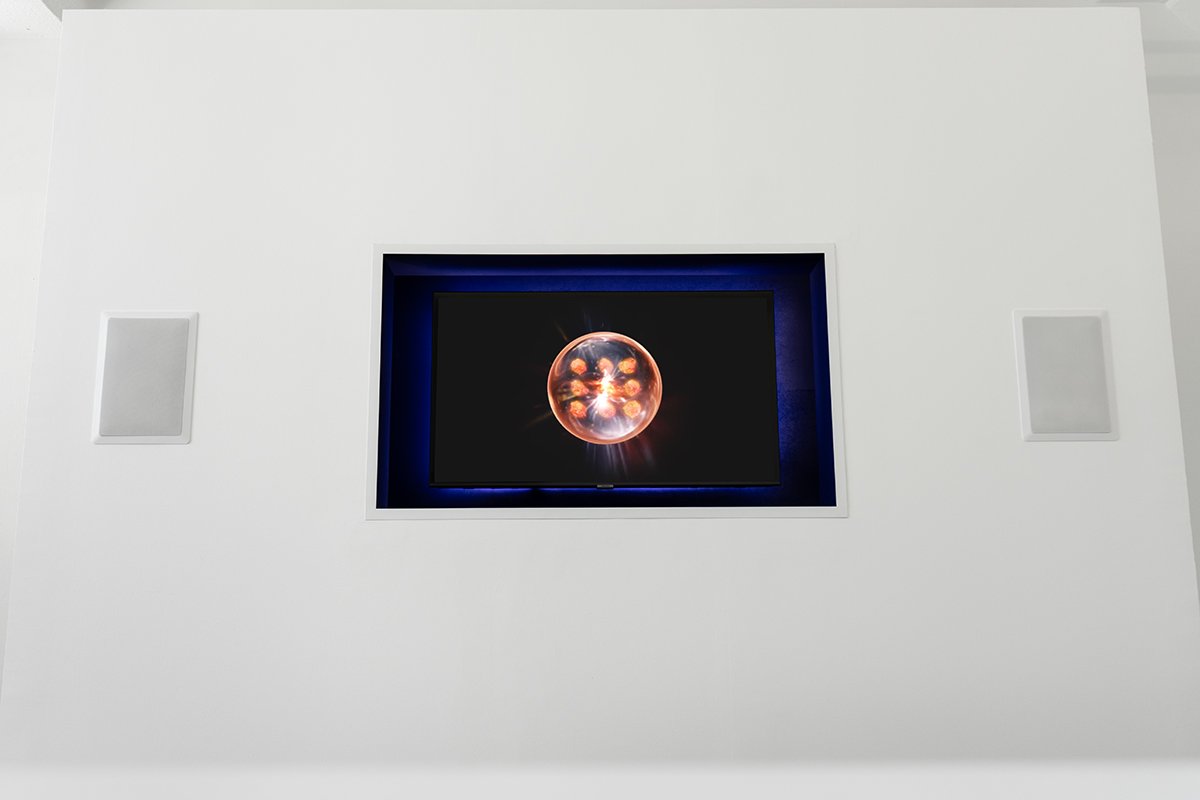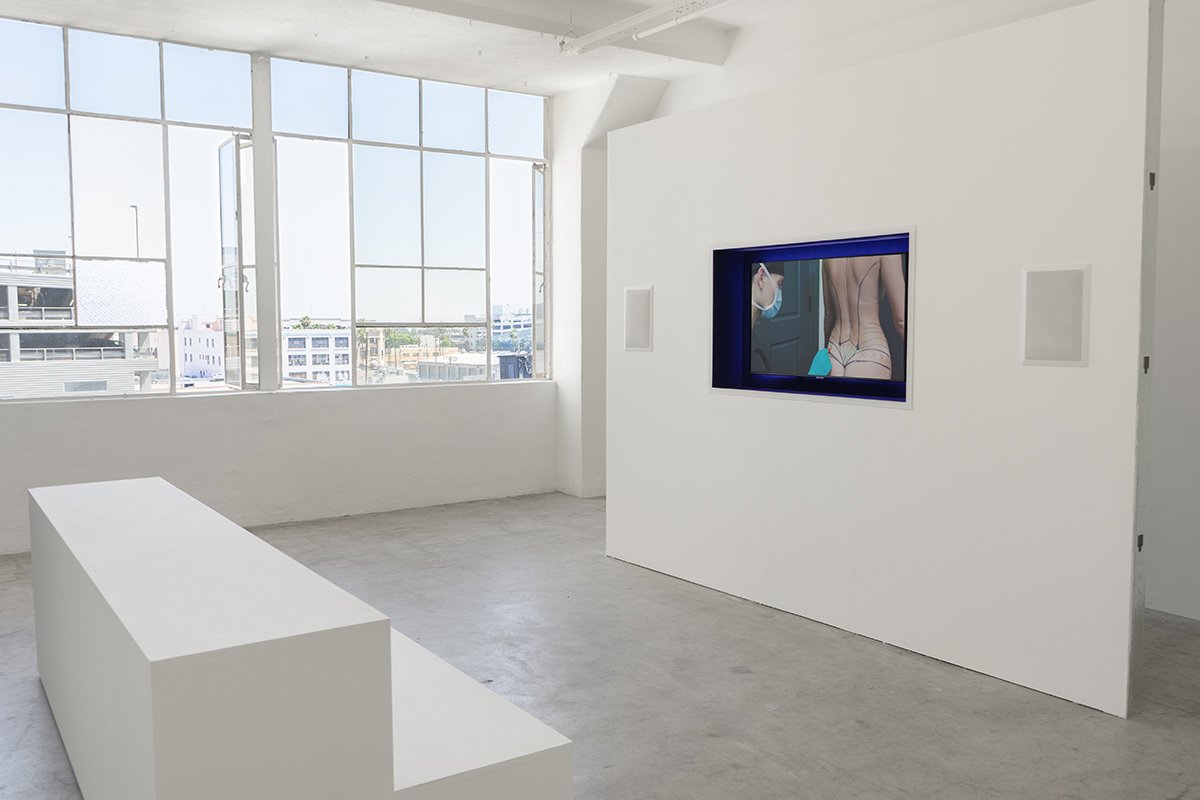A Diamond is Forever





As time passes, and as spaces, objects, ideas, imaginations, and memories make transcontinental journeys at light speed, one is bound to think if some memories, some sections of pasts and futures, some objects, some time-lags, some undiscovered seeds, some branches with half-ripened fruits, some dust, desires, and restlessness - escape through the wormholes of these speeding tunnels. Do these escaped living artifacts take the shape of earworms, which get stuck in our heads as sounds, or knocks on the door when no one is really there, or untimely strikes of numbness that feel like ants walking? It is almost as if these ever-pervasive stimuli, without articulate origins, reproduce and construct parallel lives-languages as loophole forms of consciousness - beneath our skins and the air we inhale.
Canadian artist Stephanie Deumer picks one such preservative-like, myth-making living artifact that balances at the tips of our lost tails - appearing in places where tails brush through but miss the eye. Deumer’s project, ‘A Diamond is Forever,’ is a sculptural video installation that explores the long-standing perpetuation of whiteness and patriarchy in the extraction, production, circulation, and marketing of diamonds (1). The primary film detaches and delicately puts together found footage from audio-visual media (commercials, films, music videos, social media) to untangle the yarns behind the myth of diamond and the unreality that makes it consumable, orchestrating breaks and cuts in feedback loops which have otherwise been made to feel ‘naturally eternal’ yet on the contrary - also ‘immutable.’
Creation (and Dust)
How did things come to be? Not as they are now, but in the first place itself…? With preliminary questions still unanswered - how did the formless soup of elementary particles become gendered into the myth of man and woman? Into the image of a woman birthing, nothing more - so rigid, so unimaginative, so unfair to the varied chemical processes of the vastness of space. How did answers acquire such detachment from life and yet still shine with technological brilliance? Humanity with the face of a man - mining, enslaving, engendering.
‘The entire universe cut in half and solely in half. Everything is heads or tails in this system of knowledge. We are human or animal. Man or woman. Living or Dead. We are the colonizer or the colonized. Living organism or machine. We have been divided by the norm. Cut in half and forced to remain on one side or the other of the rift. What we call ‘subjectivity’ is only the scar that, over the multiplicity of all that we could have been, covers the wound of this fracture’ -
Paul B Preciado, ‘An Apartment on Uranus’
The first part of the film is titled Creation. Taking on a techno-eco-feminist stance from the beginning, the film begins unassumingly. A woman clothed in silver alongside a gemstone emerges from the explosion of a meteorite. Both ‘objects,’ both untouched, both untethered from their ‘earthly’ histories, both without showing the slightest signs of labor (2) undergone to produce them. The film brings together pieces from the narratives of popular audio-visual culture while slowly threading a reflective narrative/critique in the background. Deumer isolates lines and images that echo inside the head long after the film/that particular section is over - ‘Forces of nature perfected in our greenhouse…’, ‘Born in the depths of the Earth and reborn on a woman - a diamond is forever.’
The footage in this section shines so heavily that one is put face to face with the creation of the myth of the woman - with her desires and the desired, lack of pain, her spheres and her bubbles - all foretold, tiptoeing on lines conceived in ‘our’ greenhouse. A constant ever-lasting narration of radiating universalisms - an oil spill refracting the shimmers back, concealing underneath - labor, women, dust, cosmic curiosities, love in all its resounding waves/ways, and sounds of shallow breathing. Oil spills concealing imperialism’s foes.
(And Dust…)
Every year the Amazon rainforest calls to the Saharan desert to send vast amounts of dust. An estimate of 22,000 tons of phosphorus in the form of tan clouds travels from the Saharan deserts to the Amazon rainforests, giving the rainforests much-needed nutrition and support - charting a transcontinental journey of its own will, autonomy, and fulfillment. While since almost 115 years, Europeans have constantly been shipping diamonds to North America and other countries in the world from former African colonies like Namibia - where the indigenous people had attached no value to these objects for hundreds of years - they just let them sit in sand (3) and in dust. While they, too, sat and ate and rested.
Both are transcontinental arches with a myriad of journeys and stories within them, one awakens a planetary consciousness while preserving a sense of comfortable yet permeating partial displacement inherent to ecological systems of aliveness - like dust - as dust, giving way to energetic bodies impressing themselves on earth in ways consumerism doesn’t comprehend. The other is inherent in removing all the dust there is, inherent in bodies swallowing their dust and color, inherent in sharpening (4) - so that all that is ephemeral and transitory about gender, about beingness, glimmers only a single glitter - to create and to sell, to dig and to sell, to decorate - to authenticate - to fantasize and to sell, to invent histories and it’s fantastical women - and to sell.
(Is dust not as precious as diamonds are?)
Extraction (doesn’t even try to think/feel like soil (5) )
“If we want to start to rely on the objectivity of feeling, we have to accept that this cosmos is matter with a meaningful interior…Only in this way can we understand what lies beyond our limited imagination. This space beyond is the objectivity of poetic knowledge. It can not be extracted, but is accessible to be populated by the lives of others.”
- Enlivenment
During a video call, Stephanie reminds me, that the device we are talking through is a result of a systematic mechanized extraction of metals from the earth, that the physicality of technology is a constant reminder of these processes and their background of damaged politics, that who chooses which tech materializes and how - comes with its own baggage of patriarchal history. When a diamond is extracted - subsequently, meanings are made, economies of desires are produced, systems become bigger than the colonies controlled, and songs are written to lull into collective amnesia - memories of imagining bodies otherwise.
The second part of the film is titled, ‘Extraction’. A voice-over emerges - ‘Forget the stars, look at the earth, our mother, our womb, she deserves your loyalty and protection,’ with it, a man wearing the clothes of an ‘explorer’ - extracts a gemstone from inside a woman’s womb. As the stone is severed from her body, she slowly turns to ash herself and breaks, and in the shine of the gem - all is cleaned (visually); only mirror-like surfaces remain (without any reflections) - just like the bodies of women in the clippings collected in the film (without their inferences).
If the noise from processes of extraction would reach our ears at the same speed as images from visual culture and mass media do, would we still be able to hear myths? Would noise not uncover the emotional lives of background processes? Or would new technologies un-aid this process, and we’d continue to ‘thrive’ and ‘un-live’ inherent planetary connectivity? Another clipping from this section shows mines exploding sentience mechanically - in neat lines, but all we hear is a song - We dig, dig, dig! And we forget how skin burns, how eyes scuffle.
In another scene, a diamond ring hatches from inside a blue egg laid by a bird, and the bird does nothing (watering a cloud of will-less obedience) - if one stops here, possibilities could open - to feel confused, to not override anger, and as the eggshell breaks, so would the illusionary relationship between birth, diamonds, women, and the onus of ‘birthing’ the universe over an ever-lasting ‘mother’ whose imitation (6) memories are sustained through magical repetitive extraction of stories imposed within bodies.
The affective subjectivity of sentience and the expanding boundaries of personhood are reduced to objectification when an advertisement compares lab-grown diamonds to test-tube babies (7) and exclaims that the embryos may be formed in different ways, but the end ‘product’ remains the same. The rights of production are taken away from evolution’s rainbows and the impurities of causality and given to the highest bidder of false immediacy where consent is managed, extracted, dreamt of, hinted at, hardly even given, or taken. When extracting, did extraction take the time to think like soil?
Transformation (forgetfulness)
In the 1920s and 30s, the diamond and gold mining entrepreneur Ernest Oppenheimer leveraged his grip on the seemingly limitless mineral wealth of erstwhile German-controlled Southwest Africa. Oppenheimer did so by using the colonial infrastructure created by Imperial Germany, with its legacy of colonial trade as a tool for colonial violence, in a background of extraordinarily high death rates and concentration camps - giving the world an unchallenged diamond cartel and a marketing campaign which transformed it all - Diamonds are Forever (8).
But all that Oppenheimer chose to transform was the marketing campaign, he did nothing to transform the horrifying legacy of Namibia’s diamond trade. Since the 1870s, as Africans under ruthless duress extracted unprecedented supplies of diamonds, European colonizers helped to maintain an illusion abroad that diamonds were scarce - and therefore valuable. The purchase of mass-marketed diamonds inherently fueled and subsidized European violence in colonies. American materialism and sexism directly enabled the European empire in Africa.
The third section of the film is titled ‘Transformation’ and begins with a voice-over of a man - ‘Doesn’t it bother you that she’s getting a C-section, I mean, that body was so flawless, so banging'!’ It’s during this section of the film that narrative linearity outrightly breaks apart, and the boundaries that neatly separate spaces and times away from each other become open to the intervention of Stephanie’s editing-unmaking - by making apparent the connections between the invisible colonial legacy of diamonds, the projection of patriarchal ideals and fetishes onto the bodies made women (9), and the technoscientific construction (10) of an object which can sustain-contain the vast distance between embodied poetic objectivity and imagined perfectionist performativity without getting caught.
‘Another evaluation of the diamond is its cut,’ says another voiceover, and the screen is later mystified-weaponized by the allure of technological prowess that makes cut-ups possible - of diamonds, land, bodies, of audio-visual handouts selling their own versions of what freedom can look like depending on who looks like whom, deciding where to cut - editing out scopes for multiple endings.
Stephanie talks about the role of editing in her artistic practice as a sort of exercise in ambient attention, highlighting pigments from everyday found-frame bruises - detaching from the indulgence of accumulated presuppositions living in the spaces between images, sounds, and words. The artistic discoveries/subversions of the ‘cuts’ or edits from ‘A Diamond is Forever’ to me are akin to processing into the cultural long-term memory of the viewer - all that which hadn’t seen rest, which had been found and stored but got stuck in losing its substance over and over again, whose invisibility often transforms into political intuitions, and whose ambient participation like a silkworm slowly produced threads of fantasia.
This exercise in ambient attention then brings forth what ‘transformation’ can come to mean to seemingly unconnected dots, how it can transform the seasons in one’s dreams and the screams in one’s nightmares, how it can create potholes in evolutionary cycles, or get rid of cycles of altogether, how it can freeze melting and care, orchestrate interruptions and speeds of breathing, how it can transfigure thoughts into non-thoughts. How it can aggress, digress, regress, how it can let go of millions of diamonds, resembling shards of glass, and how it can let these shards decide how to partition continents and gestures (11).
Value (wording)
Stephanie shares with me a list of words she wrote down when ideating ‘A Diamond is Forever’ - ‘she’s a gem,’ ‘flawless,’ ‘precious,’ ‘polished,’ ‘hidden gem,’ ‘diamond in the rough,’ ‘my rock,’ ‘pure,’ ‘refined,’ as if pointing out tears in the internal fabric of every day, in the mundane, in the overdetermined, in the immanent distances within a single bridge and it’s self-contained whole. Words corresponding to wishes of something happening, without anything changing. A language that assumes to fill in the gaps of a fragmented existence so that nothing is missing, a language separate from poiesis (12) overlooking cycles of inner incoherence.
How does language find ways within itself to construct places to not move around in or through them? How are these places not laced with caterpillars eating out the inadequacies of familiarity and repetition? How long can one hear all that which is not spoken while these words obstinately persevere? How can alienation survive in the same brackets as the seemingly universal?
The fourth section of the film is titled, ‘Value,’ and begins with a scene from the Titanic, where Rose is being given a diamond and the man says, ‘There’s nothing I wouldn’t give you, nothing I’d deny you, if you wouldn’t deny me,’ as if a diamond is forever, and so are the strings attached to it. In another scene, a diamond is being auctioned - eventually to be bought for twenty million francs. The diamond is not auctioned alone in a case of velvet or glass, but on the body of a woman - the woman as an imaginarily real case for the diamond.
‘Will she say nothing at all’?
Privilege (or else hanging by a thread)
“If walls are how some bodies are stopped, walls are what you do encounter when you are stopped; when you pass through. Again: what is hardest for some does not exist for others…When we speak about what we come against, we come up against what we speak about. Another way of saying: walls come up when we talk about walls” -
Sarah Ahmed, Living a Feminist Life
Privilege hides infinitesimally - a number larger than zero and smaller than the smallest real number, with the ability to not let cracks in walls have room for fidgeting, neither letting the order of zero/nothingness disintegrate walls nor making room for real numbers - infinitesimal concealment without infinitesimal resistance, dwelling in places without space for the residence of absence - a buffer zone without questions.
The fifth section of the film is titled ‘Privilege’ and reminds one of the colonial histories of not just the construction of the facade of diamonds and jewels but also of ideas of beingness. As if imperial cabinets of curiosity didn’t die out but spread so widely that they now inhabit spaces inside the spine - looking for lines of tropics and enigmas of exotic ebbs of blood and bacteria, replacing their walls and doors by the skin of every imagined ‘orient’ (13) square-inch of skin - efforts at the unwilful de-subjecting within subjects.
During this section, a monarch scolds, ‘It is treasonous to interrupt my beauty sleep… my face is a rare gem’, suggesting the civilian who interrupted be beheaded. I have often felt that slumber (not rest) and privilege share a common thread in their DNA, that both can make invisible and futile the embodied causality of action through tools of passivity and technocratic hierarchy - so that space travel can bring back rocks from the moon, just as western narratives of discovering new worlds brought back diamonds and the globular control and standardization of moral compasses.
Through Deumer’s film, one is struck by the absence of information about Africans in the American audio-visual material on diamonds - the people whose work powered the industry - who they were, where they came from, and how they toiled - the Pedi, Tsonga, Swazi, Sotho, Herero, Nama, San, and Ovambo laborers extracting their value from the gaze of imperialism. Steven Press, in his book, ‘Blood and Diamonds,’ examines this case in detail, giving the example of a brochure printed in 1904 by Loftis Bros., a Chicago-based jeweler. Its pages comfortably pretended that no Africans touched the stones prized in the US. The brochure did not once refer to humans removing diamonds from the Earth. “Diamonds ‘are found.’ Blue ground ‘is hauled to the surface.’ Mines ‘are worked.’ Methods ‘are employed.’”
In the living oral history of diamond mining in India, the tale of how miners smuggle diamonds by tying a thread to them and hanging those threads by their teeth is widely known. Hanging by a thread between the crevices of the teeth, accustoming the superpositions of the pressure put on this thread - could decide if the diamond shards would be swallowed before successfully being smuggled, bleeding internally, or nothing would be spoken, no walls broken, which could break this thread. A thread that would never make it to a cabinet or to colonial curiosity.
Eternity (and all that perishes)
Are all things that remain - true? Are vanitas as real as ghosts are? Do ghosts tell stories that belong nowhere but ‘here,’ but not ‘now’? Is death the order of the eternal and infinite and not life? Does inconsistency persist in the midst of the universe of consistency that we call reality? Would our hiatus be recorded in the layers of the earth just as our production does?
The last section of the film is titled - ‘Eternity,’ and as it exclaims over and over that diamonds are forever, one is bound to think of all that which is not. All the specks of cosmic debris swallowed by solar storms, the changing electromagnetic barriers between planetary identities, the everyday potentials of calluses reconfiguring their places in the world, and the coordinates of bodies in an expanding mesh of time-space. In the eternal promise of the diamond lies the market’s first and last hope, its own change of patterns from a logic of substitution (14) to the mystical allure of ‘the forever.’
‘Impervious to the laws of linear temporality,’ diamonds are here to stay - becoming psychobiological feelings and bodies that loom, with algorithms as their new merchants and stakeholders. Stephanie writes to me that in the background of her selection of found footage is also the passive stirrer of algorithms, informing where we look, how far we go, how quickly we tire, and how we are seen. By tracking finite factors of mortality, more and more is fed to the infinite stream of information of databases - which remembers all (the links) that we’d forget in order to change how we present and are represented, and hierarchies of sexual differences could continue to profoundly affect what technoscience funds and what it doesn’t.
One piece of footage stays with me throughout the film - a Tik-Tok clip of a woman removing thirty thousand individual stones glued to her body, she says how it hurts and sighs as to why she glued them in the first place! The footage de-petrifies the petrified relations between the myth of the woman and the myth of the diamond - as if opening the backdoors of diamond laboratories and gushing all those stones to flood the lab, capturing the knots that stick to the body and grow like moss, contorting in directions which swallow the sense of eternal in the mortal - in the guise of a virgin eternal continuity.
(and all that perishes)
Is transitory translucent momentary aliveness not at stake whenever capital transforms whatever is alive into resources that can be sold and packaged with limiting notions of what it means to be in the world?
Stephanie Deumer’s project, ‘A Diamond is Forever,’ continually asks about the absent presence of all that perishes while the living myth of the diamond lives forever, tracing charts where all bodies and their dilemmas have vanished by way of orchestrating pauses, junctions, and echoes. Deumer pauses at instances that seem to be protecting networks of circulating myths and enigmas, looking for patterns that ‘cut,’ ‘polish,’ ‘refine,’ and make precious. With found footage from the onset of ‘modernity,’ a period of more than a century and a half - the project breaks assumptions of linear temporality and evolution to find all that escapes, is allowed to escape, is subsidized to escape, and is desired to be escaped, in structures which continually thrive on notions construed by patriarchal imperialism. The project asks, how could loopholes flourish in separate streams of placelessness if dilemmas really were alien to the profoundness of each other?
Riya Raagini
August, 2023
——————————————————————
1. Artist’s Statement of the project, Prospect Art. “Stephanie Deumer & Prospect Art,” n.d. https://www.prospectart.org/new-page.
2. “The work of repetition involves the concealment of labor under the sign of nature” - Ahmed, Sara. The Cultural Politics of Emotion, 2014.
3. ‘Owners of a diamond have a sense that it emerges in stages: by nature, by a miner’s labour, and then by a cutter’s skill. Less appreciated is how a diamond is an invented product. Outside of limited and relatively recent industrial uses, a diamond’s consumption historically has much more to do with prestige than utility. Arguably no place on earth better illustrates that principle than does Namibia, formerly known as German Southwest Africa. For hundreds of years Namibia’s indigenous people had little use for diamonds, regarding them as objects to which they attached no value and which they generally let sit in sand.’ - Press, Steven. Blood and Diamonds: Germany’s Imperial Ambitions in Africa, 2021.
4. The sharpening of knives as opposed to collecting and discovering, the killer story of humanity which tells only on hunters bashing, thrusting, raping, killing and all about the hero - Le Guinn, Ursula K. The Carrier Bag Theory of Fiction
5. “Only the mountain has lived long enough to listen objectively to the howl of a wolf”- Leopold, Aldo. Think Like a Mountain, 2021.
6. ‘…gender parody reveals that the original identity after which gender fashions itself is an imitation without an origin.’ - Butler, Judith P. Gender Trouble: Feminism and the Subversion of Identity. Routledge Classics Ser., 2006. https://doi.org/10.1604/9780415389556.
7. The author refers to language as it appears in the found footage used by the artist in A Diamond is Forever, Stephanie Deumer vid. 2022
8. Press, Steven. Blood and Diamonds: Germany’s Imperial Ambitions in Africa, 2021.
9. ‘Through repeating some gestures and not others, or through being oriented in some directions and not others, bodies become contorted; they get twisted into shapes that enable some action only insofar as they restrict capacity for other kinds of action…Bodies take the shape of norms that are repeated over time and with force.’ - Ahmed, Sara. The Cultural Politics of Emotion, 2014.
10. “The women’s health, peace, and environmental movements all initially saw science as alien and opposed women’s interests. This was in particular to a reaction to the way biology and medical science had cast women as different and inferior, and made a case for biologically determined sex roles’ - Wajcman, Judy. TechnoFeminism, 2004. https://doi.org/10.1604/9780745630434.
11. ‘Without the marketing of diamonds, the partition of Africa would likely have looked different’ - blood and diamonds.’ - Press, Steven. Blood and Diamonds: Germany’s Imperial Ambitions in Africa, 2021.
12. ‘This poiesis is not about a language game. It is rather the element that brings forth reality. Poiesis cannot be shut down. It can only be overlooked or misunderstood in an always painful, and often potentially lethal, way.’ - Weber, Andreas. Enlivenment: Toward a Poetics for the Anthropocene, 2019.
13. Orient as imagined geographic and political territory -Said, Edward W. Orientalism. Vintage, 1979. https://doi.org/10.1604/9780394740676.
14. Orient as imagined geographic and political territory -Said, Edward W. Orientalism. Vintage, 1979. https://doi.org/10.1604/9780394740676.
——————————————————————
All images courtesy of Gemma Lopez unless otherwise noted.
All images are installation shots of “ A Diamond is Forever” taken at TSA, Los Angeles, August 2023.
————————————————————————————
Stephanie Deumer is a Canadian visual artist currently living and working in Los Angeles, California. Her multi-media installations often highlight interrelations between different kinds of reproduction—including biological, visual, mechanical, and social. More particularly, the exploration of feminine constructs is a crucial through-line in Deumer’s practice. Complexities of female identity formation figure prominently, specifically in relation to language, media, science, and technology.
Deumer holds a BA from the University of Guelph, Ontario, Canada, and an MFA from California Institute of the Arts, Valencia, California. She was a fellow at the Whitney Independent Study Program in New York, and has been awarded grants from the Canada Arts Council, Robert Rauschenberg Foundation, and Bar-Fund LA. She has been an artist in residence at Factory Media Centre, Hamilton, Ontario, Canada (2021); Banff Centre for Arts and Creativity, Banff, Alberta, Canada (2018); Cerritos College, Cerritos, California (2016); and The REEF, Los Angeles, California (2015). Her work has been profiled in ArchDaily, Dezeen, and CalArts’ 24700, and featured in The Art Newspaper, World Architecture, Time Out Riyadh, Palm Springs Life, and Creative Boom, among others. She has exhibited internationally in Canada, the United States, the UK, Ecuador, and Saudi Arabia.
In 2022, Deumer participated in Desert X Al’Ula in Saudi Arabia, creating her largest installation to date: a solar-powered video installation that cultivated native plants. As part of her continued exploration of simulacra and immersive environments, the work brought to life the spectacle of biological reproduction through technological and visual means.
Prospect Art is pleased to have commissioned Ms. Deumer’s project A Diamond is Forever, a sculptural video installation exploring longstanding perpetuations of whiteness and patriarchy in the extraction, production, circulation, and marketing of diamonds. Culling appropriated footage from the media, such as commercials, films, and music videos, the work considers how concepts of nature and commodity are used to both validate and scrutinize women and people of color in relation to diamonds. Diamonds figure literally in the work as well as figuratively, embodying the fractured and multitudinous aspects of the enigma of ‘woman’ created by the diamond industry and its market economy.
